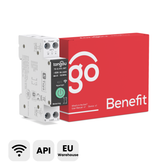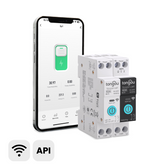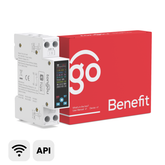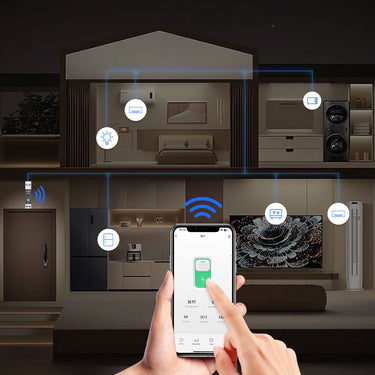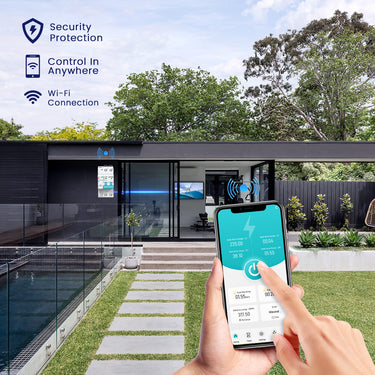What is a Remote Controlled Circuit Breaker and Switch? What Are Its Advantages?


Remote control your home with tongou TO-Q-SY1
Decoding Remote Control: The Foundation of Smart Electrical Management
What is Remote Control in the Smart Home Ecosystem?
Remote control, in the context of smart homes, refers to the ability to operate and monitor devices from a distance using a wireless signal. This typically involves using smartphones, tablets, dedicated remote controllers, or even voice commands, connected through Wi-Fi, Bluetooth, or other wireless networks. These controllers interface with various electrical components like smart switches and circuit breakers, offering users a seamless and intuitive way to interact with their home's electrical infrastructure.

The Technology Behind Remote Operation: How It Works
Understanding the operational mechanics of remote-controlled smart devices is key to appreciating their value. The process generally involves several interconnected components:
-
Communication Protocols: The Language of Smart Devices
Remote-controlled devices utilize various communication protocols to send and receive commands. Common protocols include:-
Wi-Fi: Allows devices to connect directly to your home's wireless network, offering easy setup and control via a smartphone app from anywhere with an internet connection. This is a popular choice for many smart home devices due to its ubiquity.
-
Zigbee/Z-Wave: These are low-power mesh network protocols specifically designed for smart home automation. They often require a dedicated hub but are known for their reliability and ability to extend range by hopping signals between devices.
-
Bluetooth (Low Energy - BLE): Primarily used for short-range control, Bluetooth allows direct communication between a smartphone and a device without needing a Wi-Fi network, though range is limited.
-
-
Smart Hub Integration: The Central Command Center
Often, these smart devices are connected to a smart hub (e.g., Amazon Echo, Google Home, Apple HomePod, or brand-specific hubs). The hub acts as a central controller that manages and orchestrates communications and commands between various smart devices and the user's controller (app or voice assistant). This enables more complex automations and interoperability between different brands and types of devices. -
Mobile Applications & User Interfaces: Your Control Panel
Users typically control and monitor their smart switches and circuit breakers through dedicated mobile applications provided by the device manufacturer. These apps offer intuitive interfaces to turn devices on/off, set schedules, monitor energy usage, receive notifications, and configure settings. Many also integrate with voice assistants for hands-free control.
Types of Remote-Controlled Smart Electrical Devices: A Closer Look
Remote-Controlled Smart Switches: Effortless Appliance and Lighting Control
Remote-controlled smart switches allow users to turn lights and other connected appliances on or off remotely. They can replace traditional wall switches or come in the form of smart plugs. Beyond simple on/off functionality, many smart switches offer features like:
-
Dimming capabilities for lights.
-
Setting schedules and timers.
-
Integration into "scenes" (e.g., a "Movie Night" scene that dims lights and turns on the TV).
-
Voice control through compatible assistants.
The Tongou TO-Q-SY1, for example, provides such smart switching capabilities for enhanced home automation.
Remote-Controlled Smart Circuit Breakers: Advanced Electrical Safety and Circuit Management
Remote-controlled smart circuit breakers take electrical management to the next level. They enable users to monitor and control the electrical supply to various circuits in their home remotely. Key functionalities include:
-
Remote tripping and resetting of circuits.
-
Real-time energy monitoring for individual circuits.
-
Overload, short-circuit, and sometimes over/under voltage protection with instant alerts.
-
Scheduling power to specific circuits.
These devices offer a granular view and control over the home’s electrical distribution, significantly enhancing safety and management. Some advanced devices, like certain configurations of the Tongou TOQCB2 series, may combine both smart switching and circuit breaker functionalities.
The Transformative Advantages of Remote Electrical Control in Your Home
1. Unparalleled Convenience and Accessibility
-
Remote Access: Allows users to control lights, appliances, and breakers from any location with an internet connection, whether inside or outside the home. Forget to turn off the AC? Handle it remotely.
-
Intelligent Scheduling: Enables scheduling of devices to turn on or off at specific times or based on triggers (e.g., sunrise/sunset), enhancing convenience and automating daily routines.
2. Driving Energy Efficiency and Cost Savings
-
Optimized Energy Usage: Helps reduce energy consumption by easily turning off devices that aren't in use, even when you're not home. Eliminate standby power waste from forgotten appliances.
-
Insightful Energy Monitoring: Provides detailed energy usage statistics and trends for connected devices or entire circuits, aiding in identifying high-consumption devices and managing energy more efficiently, potentially lowering utility bills.
3. Bolstering Home Safety and Security
-
Proactive Alert Notifications: Sends alerts to your smartphone during electrical faults, overloads, or unusual activity, allowing for timely action to prevent hazards like electrical fires or equipment damage.
-
Emergency Remote Shut-Off: Offers the critical capability to remotely shut down specific circuits or even the main power supply in an emergency (e.g., water leak near electrical outlets, suspected electrical fire), preventing potential damage or life-threatening risks.
-
Enhanced Security: Simulate occupancy by scheduling lights to turn on and off while you're away, deterring potential intruders.
4. Seamless Integration with Smart Home Systems
-
Interoperability: Integrates seamlessly with other smart devices like motion detectors, door/window sensors, smart cameras, and voice assistants (Alexa, Google Assistant, Siri).
-
Automated Scenes and Routines: Allows the creation of sophisticated automated scenarios, such as an "Away" mode that turns off all unnecessary lights and appliances and arms security features, or a "Good Morning" scene that gradually turns on lights and starts the coffee maker.
5. Personalized Customization and Future-Proof Scalability
-
User-Defined Preferences: Customizable settings to match individual user preferences, such as setting specific dimming levels for lights, preferred fan speeds, or custom alert thresholds.
-
Expandable Systems: Easy addition of more smart switches or circuit breakers to the existing smart network as your needs grow or as new smart devices are acquired, ensuring the system can adapt over time.

Real-World Applications: Remote Control in Action Across Home Segments
Remote-controlled smart switches and circuit breakers can be applied across various segments of the home:
1. Living Areas: Enhancing Ambiance, Convenience, and Entertainment Management
-
Lighting Control: Schedule and remotely control ambient, task, and accent lighting to create moods, enhance security when away, and ensure lights aren't left on unnecessarily.
-
Appliance Management: Manage the use of entertainment devices (TVs, sound systems, gaming consoles), ensuring they are completely powered off when not in use to save energy.
2. Kitchen: Optimizing Appliance Safety and Energy Use
-
Appliance Safety: Remotely monitor and disconnect high-power appliances like ovens, cooktops, microwaves, and even refrigerators in case of emergency or before leaving for an extended period.
-
Energy Management: Schedule appliances like coffee makers to start brewing before you wake up or dishwashers to run during off-peak energy hours.
3. Bedrooms: Curating Comfort, Safety, and Peaceful Routines
-
Comfort Control: Use smart switches to remotely control lighting (including dimming), fans, and portable air conditioning units for optimal comfort without leaving your bed.
-
Safety: Ensure that devices like heaters, electric blankets, or those used by children (e.g., night lights, humidifiers) are turned off when not in use or after a set time.
4. Outdoor Areas & Perimeters: Extending Control for Security, Aesthetics, and Efficiency
-
Landscape and Security Lighting: Control garden, pathway, or landscape lighting remotely to enhance home aesthetics, improve security, and schedule them for automatic operation.
-
Pool and Spa Equipment: Manage pool pumps, heaters, and lighting to ensure they are only running when necessary, optimizing energy use and maintenance schedules.
5. Garages, Workshops, and Utility Spaces: Ensuring Safety and Efficient Power Management
-
Tool and Machinery Management: Remotely control power to heavy machinery, power tools, or EV chargers, reducing the risk of accidental startup and managing energy draw.
-
Lighting and Security: Manage lighting for safety and convenience, and integrate with security features to illuminate these often-overlooked areas when motion is detected.
Key Considerations Before Integrating Remote-Controlled Electrical Devices
Before investing in smart switches and circuit breakers, consider the following:
-
Compatibility: Ensure devices are compatible with your existing electrical wiring (e.g., some smart switches require a neutral wire) and your chosen smart home ecosystem (Wi-Fi, Zigbee, Z-Wave, Apple HomeKit, Google Home, Alexa).
-
Network Security: Choose reputable brands that prioritize security with regular firmware updates and strong encryption. Always use strong, unique passwords for your smart home accounts and network.
-
Installation: While some smart switches are DIY-friendly for those with basic electrical knowledge, smart circuit breakers typically require installation by a qualified electrician to ensure safety and compliance with electrical codes.
-
Internet Dependency: Understand how the device functions if your internet connection goes down. Some devices may offer local control or retain schedules, while others might be inoperable without an internet connection.
-
Cost vs. Benefit: Evaluate the initial investment against the long-term benefits of convenience, energy savings, enhanced safety, and increased home value.
Frequently Asked Questions (FAQs) About Smart Switches and Circuit Breakers
-
Q1: Can smart switches and breakers save me money on my electricity bill?
-
A: Yes, by allowing you to optimize energy usage through scheduling, remote turn-off of forgotten devices, and monitoring energy consumption, they can lead to significant reductions in electricity waste and lower bills.
-
-
Q2: Are remote-controlled electrical devices secure from hacking?
-
A: Reputable manufacturers implement security measures like encryption and regular firmware updates. However, users also play a crucial role by using strong, unique passwords, securing their Wi-Fi network, and keeping software updated. No system is 100% hack-proof, but risks can be significantly minimized.
-
-
Q3: Do I need a smart hub for all remote-controlled switches and breakers?
-
A: Not necessarily. Wi-Fi-based devices can often connect directly to your home router and be controlled via an app. Devices using Zigbee or Z-Wave typically require a compatible smart hub to communicate.
-
-
Q4: What happens if the internet connection or power goes out?
-
A: If the internet goes out, remote control and some smart features may be unavailable. Local control (manually at the switch) usually still works. Some devices might retain schedules. During a power outage, all devices will be off; their behavior upon power restoration (e.g., return to last state, default to off) varies by device and settings.
-
-
Q5: Can I install these devices myself?
-
A: Many smart switches can be a DIY project if you are comfortable and knowledgeable about basic electrical wiring (always turn off power at the breaker first!). However, smart circuit breakers directly interface with your home's main electrical panel and should generally be installed by a qualified and licensed electrician for safety and code compliance.
-
Conclusion
Remote-controlled circuit breakers and switches, exemplified by innovative solutions like the Tongou TO-Q-SY1, are genuine game-changers in the realm of home automation. They offer an unmatched trifecta of convenience, enhanced safety, and significant energy efficiency. By understanding how these sophisticated devices work, their myriad advantages, and their versatile applications in different home segments, homeowners can make well-informed decisions about integrating them into their smart home systems.
From managing lighting and appliances with a simple tap or voice command to ensuring the electrical safety of your household and optimizing energy usage, remote control features bring a new level of functionality and peace of mind. Whether you are inside or outside the home, these devices provide unparalleled flexibility, making everyday life simpler, more secure, and more efficient.
As these technologies continue to evolve and mature, they will undoubtedly become even more integral to modern homes, fostering smarter, safer, and more connected living environments. Embrace the future of home automation by exploring and integrating remote-controlled switches and circuit breakers into your home today, and experience the profound benefits firsthand.


